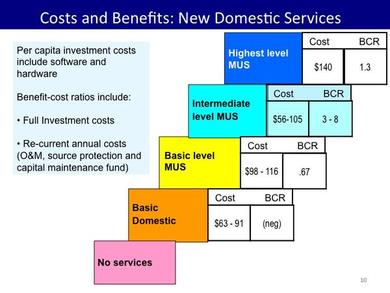How to do MUS
How to do MUS
Moving from basic supplies to MUS requires planning for higher levels of service in terms of the quantities of water supplied and distance from point of use (Figure 1). Intermediate-level MUS provides the highest benefit-cost ratio (Figure 2). In most of sub-Saharan Africa, upgrading to this level of service would mean doubling or tripling current volumes supplied, of which only 3–5 lpcd would need to be of high enough quality for drinking and cooking. Infrastructure add-ons, such as cattle troughs or outlets to communal gardens may also be required. Establishing new multiple-use services requires multipurpose infrastructure - whether pipes, pumps or rainwater harvesting reservoirs - often used in combination.

Figure 1: The multiple-use water services ladder
Source: Van Koppen 2007, p. 37
In irrigation schemes, the focus of the MUS approach is not so much on increasing the volume of water as on improving access for multiple uses, such as for watering cattle, washing clothes or diversions to reservoirs that could supply households or entire municipalities. FAO’s Mapping Systems and Services for Multiple Uses (MASSMUS) guidelines have been used to reform large-scale irrigation systems to support multiple uses in China, India and Vietnam.
At the policy level, MUS requires unlocking budgets and expertise from the restrictions of single-use systems. It requires supportive norms and standards, more flexible management and operations, and a greater emphasis on the capacity of service providers to adapt services to the needs of users. And it requires transparent, inclusive, participatory planning in which communities are empowered and informed about the technical and institutional options available, and the financial and management implications.
Overcoming barriers
‘It’s not my job’– Professionals in the WASH and irrigation sub-sectors are discouraged or even prevented from responding to people’s multiple water needs by perverse incentives, rigid accountability structures, and ring-fenced budget lines. As a result, few public service providers systematically take responsibility for improving poor people’s access to water for domestic and small-scale productive uses. Overcoming this barrier in the short-term will require adjusting mandates and giving local officials more discretionary decision-making power to meet all basic needs. In the long term, it will require training programmes and revised curricula for water professionals.
Water quality concerns– Critics of the MUS approach have objected that using potable water for productive uses is wasteful, or that enabling people to access poor-quality irrigation water for domestic use is irresponsible. But these arguments fail to take into account a number of factors:
- the reality on the ground – many people already use domestic water supplies for productive purposes and irrigation systems for domestic purposes;
- the opportunities to minimise risks and increase benefits, such as through low-cost, point-of-use treatment of drinking water and matching available water sources to appropriate uses based on quality and other criteria; and
- the superior benefit–cost ratio of multiple-use services compared with basic domestic services

Figure 2: Incremental benefit–cost ratios (BCR) for new services
Source: Renwick (2009) Multiple Use Water Services for the Poor, slide 10
‘More for some instead of some for more? How can we afford to upgrade services when many still lack basic access to safe drinking water?’ This is the dilemma faced by many countries. Although it is true that multiple-use services often require a higher initial investment, taking a MUS approach gives users a greater stake in sustaining the service and income to pay user fees or even to repay capital costs. Based on research in Senegal and Kenya, it has been calculated that users could repay capital costs of upgrading to intermediate-level MUS within one year for surface gravity-fed systems and around two years for groundwater pumped systems. For new intermediate-level MUS systems, the estimated repayment period is within 13 months for gravity-fed spring systems, and within 30 months for piped systems. With access to well-targeted subsidies, loan schemes and appropriate technical support, households and communities would not have to wait for public services to reach them.
In irrigation schemes, a MUS approach can include the landless and other non-irrigators in a share of the benefits and increase sources of revenue, which could be used to extend the scheme to cover new users.
Shifting from single-use approaches to more flexible multiple-use approaches requires changes in thinking, policy and practice. But the payoff is a broader range of health and livelihoods benefits than from single-use interventions, more sustainable systems with better buy-in from users, and new opportunities for financing.
More information on how to do MUS can be found in the toolkit which is compiled on experiences of MUS Group members.
